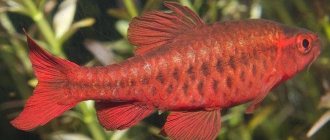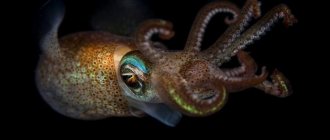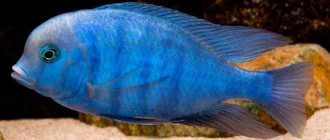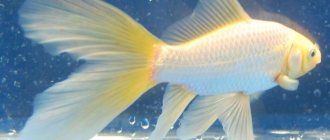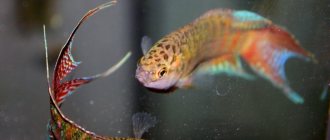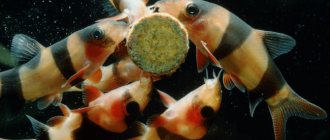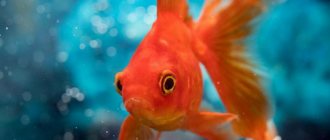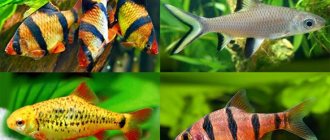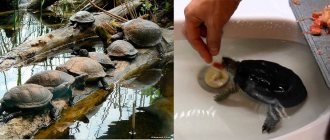5
(5)
Today, the shark baloo is one of the most interesting representatives of the underwater fauna. It’s worth noting right away that he is in no way related to the famous bloody predators. It is called so solely because of its certain resemblance to a shark. But, despite its rather menacing appearance, it is a completely calm and peaceful fish that does not pose a danger to its neighbors in the aquarium (of course, if they are not so small that they can be eaten).
Description
Amazing large fish. There are nuances, but the appearance is unpretentious and hardy.
Appearance
The body shape is oblong, torpedo-shaped. The dorsal fin is high, reminiscent of a shark. Size up to 35 cm, in an aquarium it often grows to 20–25 cm. The color is silver, light in the belly area, darker near the back. The fins have a stripe of white or yellow color, with a dark edging. The fins on the chest are colorless. The mouth is located below.
Behavior
Baloos are not a predatory species. They do not attack smaller neighbors, with the exception of very small fish. Alone they become aggressive or depressed. They are mobile and prone to jumping out of the water. They do not spoil the plants. Most balus are caught from the wild and are therefore not adapted to life in an aquarium. It takes Shark Ball several weeks to adapt to a new location. Barbs are very timid; sudden movements and loud sounds make them rush around and hit the glass.
Lifespan
In good conditions, domestic sharks live 10–12 years.
Interesting Facts
Dynamic and playful, Balantiocheilus are amazing representatives of the underwater fauna. The version of the interlingual transformation of the generic and species name ( balantiocheilos melanopterus) consists of the distinctive features of the fish, where:
- balantion – bag and cheilos – lip, which is determined by the structure of the individual’s mouth;
- melas – black and pteron – wing, an interpretation of the shape and pattern of the fins.
The word “shark” in the name of the fish is of English origin – bala shark. And since the species has no related relationship to a marine predator, we can assume that this is a commercial marketing ploy that the sellers took to popularize the species.
Since 1996, the Bala shark has been included in the International Union for Conservation of Nature Red List of Endangered Species. The reasons for the population decline have not yet been precisely established. The version that this happened due to the mass capture of wild specimens for the aquarium industry has not been confirmed. Most likely, the main threat to the species is the difficult ecological situation.
The shark is listed in the Red Book as an endangered species
Baloo sharks are active and spectacular pets, the beauty and grace of which can please the aquarium breeder for a long time. Despite the fact that fish breeding is difficult at home, watching a school of active shark barbs brings satisfaction and fills you with energy.
Content
Difficulty in keeping is due to its large size and the need for flocking. An important condition for existence is the ability to swim freely.
Aquarium
For a flock of 5 individuals, you need an aquarium with a volume of 560 liters. A lid for the aquarium is required. Soil, decorations, plants if desired, allocate a minimum of space for them.
For decoration use:
- grottoes;
- large stones;
- driftwood;
- pots;
- figurines.
- elodea;
- hygrophila;
- Java fern;
- Anubias;
- mosses;
- Cryptocoryne.
Water parameters
Active aquarium inhabitants need clean water with moderate movement. Change water 25% once a week. Valid parameters:
| acidity | 6.0–8.0 |
| rigidity | 5.0–12.0 dGH |
| water temperature | 22–28 degrees |
Plants
When landscaping the pond, give the shark barbs enough space to swim. There is no need to create thickets. Plants with hard leaves that do not require a lot of light are suitable:
Priming
Baloo rarely dig, so a variety of substrates can be placed at the bottom. Small pebbles will recreate the natural habitat of fish. Balls look better on a dark background, so choose the ground and background appropriately. Siphon the soil weekly to keep the bottom clean.
Equipment
Create a flow with powerful filters and pumps. Take care of aeration, the water should be rich in oxygen. Get a thermometer to keep the temperature at an appropriate level. Install a heater if necessary.
Lighting
Silver fish do not like bright light. Carp sharks thrive in natural sunlight, but exposure to rays stimulates algae growth. Choose dim fluorescent lamps to recreate soft natural lighting. Daylight hours: 8–10 hours.
What should an aquarium be like?
These fish are active, mobile, but shy; they require free space for swimming and vegetation, which they use to hide. To make your pets comfortable, they need to provide them with a suitable home:
- It is important to consider the size of the individuals and schooling - the fish will need a large, spacious tank. Juveniles can be kept in a 300-liter tank, but adult fish will require a 400-liter tank or larger.
- It is advisable to choose an oblong rectangular container, the length of which is at least 2 meters.
- The container must be equipped with a lid - balus can jump out of the container and die.
- The aquatic environment must be clean - as for other river inhabitants, this is very important for the Balu.
- A filtration system is a necessary piece of equipment; it must be a powerful external device that creates an intense flow.
- Decor is important not so much for the fish as for the appearance of the reservoir. The main thing is that the fish have room to move freely. It is recommended to plant plants in the corners and along the back wall; a snag can be placed in the center of the tank.
The owners note that these mini-sharks look most impressive against the background of dark soil and the darkened back wall of the aquarium; their scales literally sparkle and shimmer.
One of the features of shark balus is their habit of searching for food at the bottom, picking up the remains, thereby maintaining its cleanliness. Unlike most bottom dwellers, these fish pick up food carefully, without uprooting vegetation or stirring up the water. These fish are also capable of making sounds reminiscent of slurping.
Feeding
The shark barb is omnivorous. In nature, they feed on rotifers (microscopic aquatic animals), small crustaceans and algae. In the aquarium they eat dry, frozen and live food. They feed in the middle and lower layers of water. They eat frequently, 2–3 times a day in portions that are eaten within 2 minutes. Choose foods that sink slowly.
Compose your diet from plant and animal products:
Baloos do not digest chitin well, so feed them rarely with bloodworms and gammarus.
Price
Balantiocheilus is rarely found on sale in markets. Such fish are most often purchased in pet stores on order or via the Internet.
| Size, cm | Average cost, rub. |
| 2-3 | 150 |
| 3-5 | 195 |
| 5-7 | 250 |
| 7-9 | 450 |
| 12-15 | 700 |
| 20 | 1000 |
Shark barbs grow quickly, and the aquarist will not have to wait long if he buys small fry.
Compatibility
Shark balus get along with active and non-conflicting aquarium fish, but neighbors that are too small (2–3 cm in length) will be eaten. Slow catfish that are awake at night and live on the bottom are also suitable. Full compatibility of the Baloo with others is ensured not only by similarities in temperament and size, but also in the required conditions.
Successful examples of fish living with Balu:
Do not place large predators and aggressive cichlids, too slow inhabitants of the middle layers of water, or fish with long fins into the jar with shark ball. Examples of unsuccessful neighbors:
Adviсe
- Turn on the light smoothly. First, dim light in the room, a few minutes later - an aquarium lamp. Then the ball will not be afraid.
- Choose a special cabinet for the aquarium. The water container is heavy.
- Clean your aquarium carefully. Baloo sharks are shy fish that experience stress due to interference.
- Place an immersion thermometer rather than an external one. Such a device will provide accurate data. The thermometer must be free of chips and damage.
- Make sure that the lamp does not heat the water too much.
- Siphon the soil and change the water weekly. By carrying out all the aquarium cleaning procedures in one day, you will cause less disturbance to the shark barbs.
- Gently adapt newly acquired balls to new conditions. Do not immerse the barbs in the vessel immediately. Place the transport bag with the fish in the aquarium water for half an hour, then gradually add new liquid. Do not turn on bright lights or feed the inhabitants of the aquarium for several hours.
- When carrying out the course of treatment, increase the water temperature by several degrees.
- Keep new fish in a quarantine tank with preventive treatments. Quarantine period: 3–4 weeks. Aquarists recommend lowering the temperature by a few degrees, then possible diseases will appear.
Baloo is not only interested in his appearance. They can make sounds. Small sharks make quite loud clicking noises when feeding. If you want to hear this, then get this fish into your aquarium!
Previous
FishBotsia marble - can sleep on its side and vertically
Next
FishSchooling fish cherry barb
Reproduction
Shark barbs rarely breed in an aquarium. Spawning is stimulated by hormonal injections and is possible in a 1500-liter aquarium. Puberty occurs at 4 years of age.
Sex differences
You can determine the sex by examining the barb in detail. Sexual differences appear upon reaching 14 cm in length. Females have a rounded abdomen, while males have a cocky character.
Spawning
The difference between a male and a female
Among young fish it is simply impossible to distinguish them; differences begin to appear only after the fish reach 14 cm, almost after four years of life. The female's abdomen becomes rounded, and the males become much more cocky and look larger than the females. Most of their holders believe that the Balu does not have sexual dimorphism.
Immediately before spawning, you can notice a kind of dance between them.
Diseases
Domestic sharks have strong immunity. With improper care and non-compliance with flocking, the following are susceptible to the ball:
Reviews
The experience of aquarists confirms the need to keep sharks in a spacious container. Many people find shark pets interesting and fascinating, as numerous reviews indicate. Some aquarists report keeping balus with goldfish and African cichlids. This experience is rather an exception, because these fish are incompatible.
